"o tempora o mores."
"Oh the times, oh the customs!"
Cicero
"The past is a foreign country: they do things differently there."
L.P Hartley
"You have learnt something. That always feels at first as if you have lost something."
George Bernard Shaw
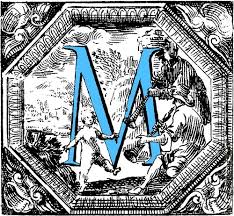 ARCH WAS THE FIRST of only ten months in the early Roman calendar. This is why today in our own calendar the last four months are numbered seven, eight, nine, and ten (septem, octo, novem, and decem). Later the Romans added January and February to the beginning of the year. Here is an actual calendar restored from Republican Rome, the Fasti Antiates Maiores, c.60 B.C.--
ARCH WAS THE FIRST of only ten months in the early Roman calendar. This is why today in our own calendar the last four months are numbered seven, eight, nine, and ten (septem, octo, novem, and decem). Later the Romans added January and February to the beginning of the year. Here is an actual calendar restored from Republican Rome, the Fasti Antiates Maiores, c.60 B.C.--
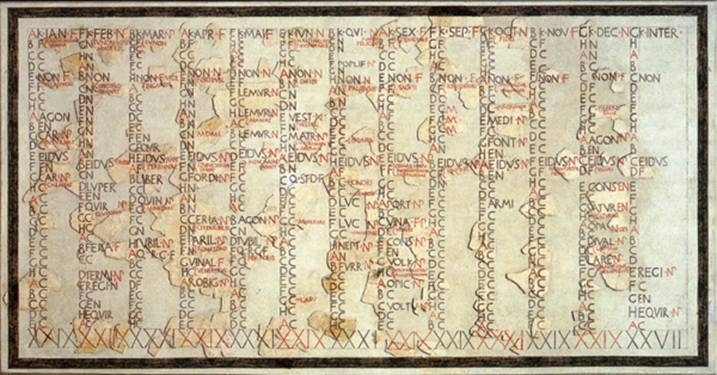
The calendar, when written out this way to show which days can and cannot be used for official business, is called the fasti. Note that the names of the months at the top of the fasti are traditionally abbreviated to three places.
The Roman Senate changed the names of Quintilis and Sextilian (months five and six) to July and August in the years 44 B.C. and 8 B.C. to honor Julius Caesar and Augustus Caesar. These names have stuck. The emperor Tiberius declined the honor when the Senate offered to name months after him and his mother. However, his successor Caligula renamed September Germanicus after his father in 37 A.D., and then in 65 Nero changed the names of April, May, and June to Neroneus, Claudius (after his adoptive father), and Germanicus (again after Caligula's father, Claudius's brother). These names didn't stick and didn't even survive Nero's assassination in 68.
In 86 Domitian renamed September Germanicus once again, but this time after himself, and October Domitianus (see note on page 210, Statius I, Loeb Classical Library, 1982--I wish I knew the evidence this was based on. Other years are candidates for this event, but their arguments aren't very convincing).
Okay, right about now I can almost hear my tastefully-select readership demanding to know, "Jim, this is all very interesting, but aren't you the guy who blogs about the Coinage of the Emperor Domitian, or are you now all of a sudden the guy who blogs about Random Changes in the Roman Calendar?"
A fair question. Actually I was just getting to the coinage angle, because also in the year 86, the same year Domitian renamed the months, the mint struck an interstitial issue of bronze coinage. Distinguished by GEM instead of GERM in the obverse inscription, this very brief issue has gone unrecognized until now. Its existence is only hinted at in RIC (Carradice and Buttrey, The Roman Imperial Coinage, Vol II, 2nd ed., London, 2007) among footnotes to the regular bronze issue of 86 (COS XII), noting one example of sestertius and three examples of as with this variant spelling and calling one of them a "die error."
Adding to those already footnoted in RIC, here is another unpublished as in the extensive collection of Alberto Tricarico--
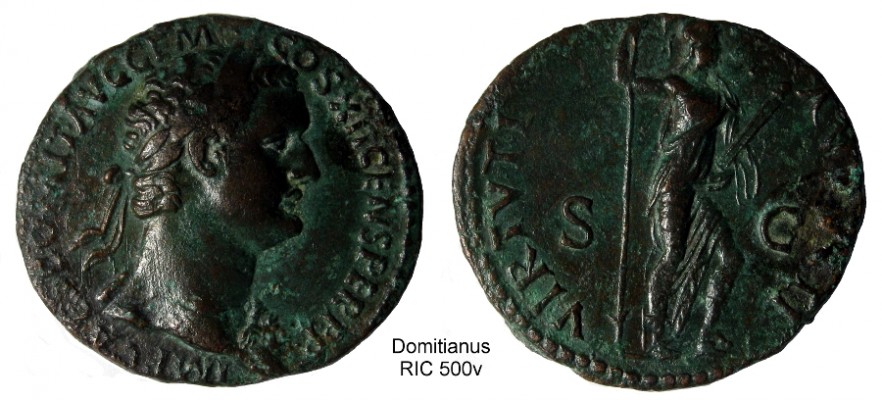
It is my contention that GEM was not a misspelling nor a die error nor any other sort of carelessness on the part of the engravers. This change of mint policy, albeit short-lived, was not only a deliberate act but a coordinated one.
Here is my example of RIC 489var--
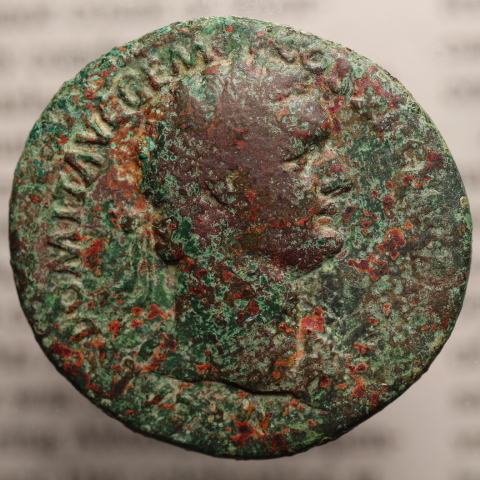
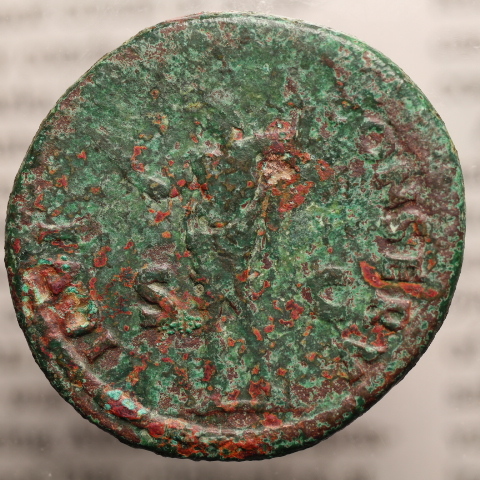
Here is Alberto's--

Here is my RIC 496 var--
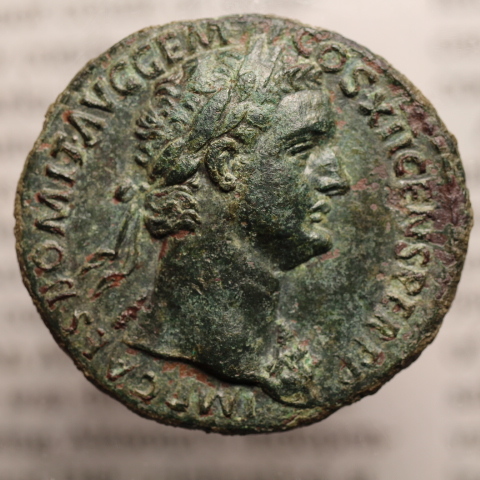

Here is Alberto's--
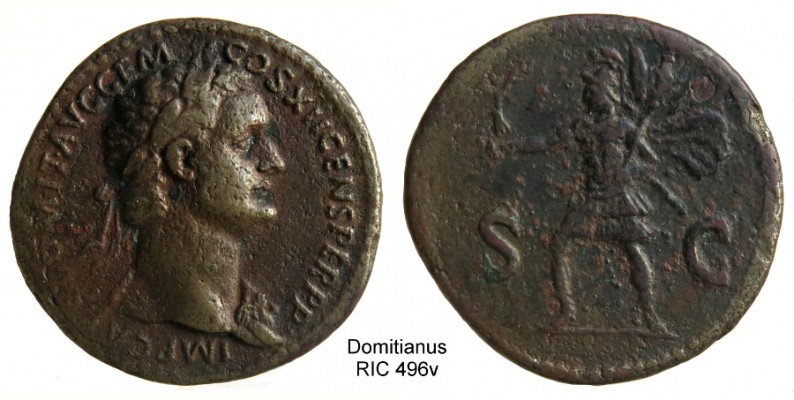
Here is my RIC 498 var--
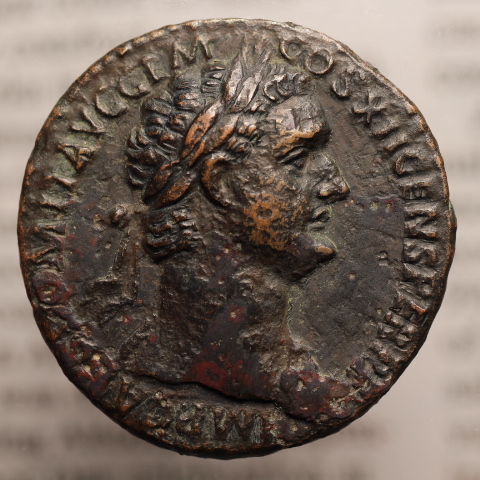
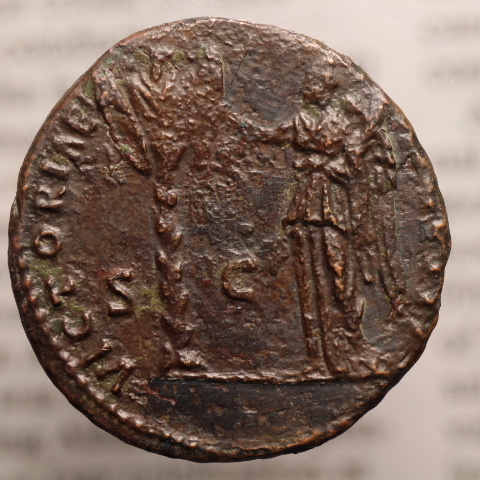
And here is Alberto's--
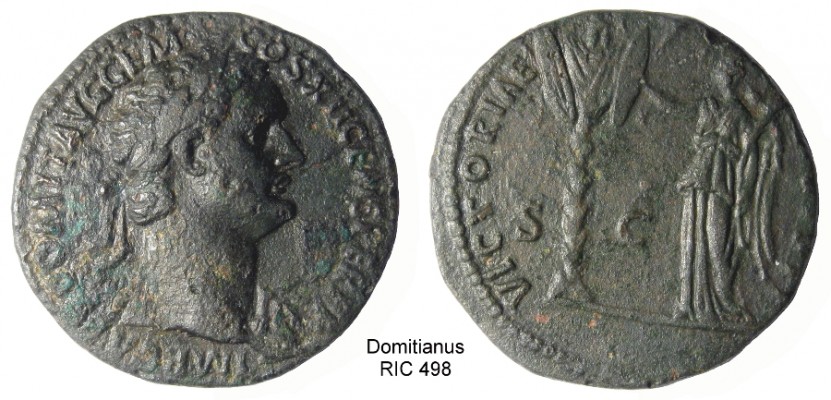
Clearly there is more going on here than engravers' errors. Four different reverses (and counting), only three of them mentioned in the standard reference, representing four different officinae, and spanning different obverse and reverse dies (oops, please see "News Flash" below. I have deleted the comments I wrote regarding die comparisons, because they were all in error, every single one) have this "engraver's error," always the same word spelled the same way and all happening in the same brief period of time apparently, and there is also a sestertius, according to RIC. If this wasn't a mistake, if it was deliberate (and coordinated), what was the purpose?
In my opinion this is evidence of the name change from September to Germanicus in 86. This was an attempt by the mint to conform to the standard of the calendar by reducing GERMANICVS from four places (GERM) to three, and GEM, not GER, is what the calendar said.
Why?
The answer to this question isn't my problem. This is a question better addressed to the guy who blogs about Random Changes in the Roman Calendar. However, I can speculate, so allow me to take a shot at it--
GER would be the appropriate abbreviation of GERMANICVS. GEM isn't an abbreviation, it's a contraction. Contractions, as opposed to abbreviations, apparently occur in Latin inscriptions, though I am aware of only one, which coincidentally appears on the coins of Domitian. On the obverse sides of the very coins pictured above note that CONSVL is contracted to COS rather than abbreviated to CON. In my opinion, this is to avoid a vulgar anatomical reference. A similar reason may serve to explain GEM instead of GER on the calendar.
Many of the most common little verbs in English carry a secondary sexual meaning. Probably anybody can come up with a dozen examples just off the top of his head. It occurred to me that the same might be true of Latin. gero, a useful little word with a hundred different meanings, seemed a likely candidate, but I couldn't find any surviving evidence either epigraphical or literary that would prove it.
So I consulted with Amy Richlin, Professor of Classics at UCLA and author of Marcus Aurelius in Love, Chicago, 2007. According to Prof Richlin, the phrase morem gero "was commonly used to mean 'do one's duty as a wife,' extended to include sexual duty, and appears in reference to male slaves used for sex by their owners with some frequency in Plautus." (Adams, The Latin Sexual Vocabulary, Baltimore, 1982.) Although Prof Richlin has expressed her doubts, I believe that through common use and in the right context gero might have been understood to mean or at least have become suggestive of morem gero.
Now, to the Romans, playing the passive partner in a male/male sexual act was shameful. Playing the active partner was considered perfectly acceptable, even when children were involved, but being on the receiving end, so to speak, wasn't something any self-respecting adult Roman male would tolerate having broadcast about. pedico was the verb applied to the active partner; perhaps gero applied to the partner "playing the wife."
What does this have to do with Domitian? In a previous article I mentioned Suetonius and his penchant for passing along rumors [this is true about Suetonius, but the blog article didn't survive the purge]. Well right off the bat in his Twelve Caesars (Domitian, 1,1) Suetonius sets us up with a doozy. Apparently there was a rumor circulating that Domitian as a young man had played the wife to Nerva, his successor to the throne of emperor!
So imagine this. Domitian, having just decreed that September is going to be called Germanicus from now on and October was to be called Domitianus, is strolling down to the forum with a couple hundred of his closest friends to look over the sign painter's handiwork on his beautiful new calendar, the gigantic fasti on the wall of the curia, and this is what he sees at the top: GER DOM, GERmanicus DOMitianus, Germanicus Domitianus, September and October. But for all the world it could just as easily stand for GERit DOMitianus, gerit Domitianus, Domitian plays the wife. (Word order in Latin, though not unimportant, is more flexible than in English.)
Furthermore, as he studies the line in jaw-dropping horror, he reads the top line from left to right, aloud (Romans couldn't read silently; libraries were very noisy places), AVG GER DOM NOV DEC, AVGustus GERmanicus DOMitianus NOVember DECember. But doesn't he also see AVGustus GERit DOMitianus N(O)erVae DECem, Augustus gerit Domitianus Nervae decem, Domitian Augustus played the wife to Nerva ten times! Prof John Pollini, Professor of Art History and History at USC and author of "Slave-Boys for Sexual and Religious Service: Images of Pleasure and Devotion," Flavian Rome: Culture, Image Context, Boyle and Dominik, eds., Leiden, 2003, has pointed out to me the laxness of Roman orthography. So I am taking a leap with N(O)erVa, but not much of one.
In a panic the emperor calls again for the sign painters! "Change it to GEM!" he screams at them. Instantly he fires off a memo to the mint. "Conforming to the new calendar," he writes, "from now on it's GEM on the coins as well!" Later that morning cooler heads prevail. "You're only calling attention to the problem this way," the wise Fabricius Veiento points out to him gently. "Let it be GERM on the coins and on the calendar." So another memo is sent to the mint and to the sign painters, hot on the heels of the first, the calendar was altered again and the coinage was restored, giving us the rare interstitial issue of 86, COS XII GEM.
Perhaps needless to say Germanicus and Domitianus didn't survive as months after the death of Domitian.
***NEWS FLASH***
I have been working on this article for weeks. Day before yesterday I was informed by no less an authority than Prof T.V. Buttrey (Documentary Evidence for the Chronology of the Flavian Titulature, Germany, 1980, and, of course, with Ian Carradice, the small-b bible, RIC) that "the GEM obverses are all, not surprisingly, from a single die." Not surprising to him, obviously, but it floored me! Looking at the photos above, perhaps this fact should have been evident even to my unpracticed eye, but it wasn't, not until he mentioned it, and now I see it and don't know what to do with the information. Does it support my thesis (perhaps this obverse was meant as a prototype) or does it cut it off at the knees (GEM was an engraver's error after all)? I have no idea. And obviously the contraction from GERM to GEM on the sestertius will still have to be explained.
I see a hand raised in the back of the room. Clearly this new revelation has spurred some questions. Yikes, there's another hand. Okay, so what I'm going to do right now is turn the rest of this blog article into a Q&A format and deal with your questions as best I can. Yes miss, you, the attractive young lady in the back row.
QUESTION: In the first draft you called us your "small but mighty" readership, but at the last minute you changed it to "tastefully-select." You probably thought that was a more subtle way of putting it. Do you do that a lot, change what you have written?
ANSWER: Sometimes, but not usually. I actually lifted large chunks of this blog article out of some emails I had written to Profs John Pollini at USC and Amy Richlin at UCLA, and I didn't have to change more than a word or two. I would like to thank both of them for their help researching this article as well as Prof John Clarke at the U of Texas in Austin and, of course, Prof Buttrey at the Fitzwilliam Museum at Cambridge. Yes, the gentleman in the second row.
Q: In a recent blog article [this one will be reprinted at a later date] you refer to Wolfgang Schürmann's Typologie und Bedeutung der stadtrömischen Minerva-Kultbilder (Rome, 1985), and the implication is that you possess a working knowledge of German. Yet looking at your copy of the book I see an inordinate amount of pencil scribbling, both interlineally and in the margins. In fact there seem to be more pencil marks in the margins than there is text on the page. How do you explain that?
A: My German is very rudimentary. Schürmann has been translated into Italian. Ordering from an Italian publisher, that was what I was expecting them to send to me. Obviously, in answer to your question, I don't speak German.
Q: Nor can you read it apparently.
A: Was that a question?
Q: Nope, just an observation. However I do have a question about the translation from Greek and Latin at the top of the blog articles and sometimes within the body of the articles. Do you do those yourself?
A: Yes I do. I'm kind of proud of them actually.
Q: Well, I wasn't going to say anything, but sometimes they strike me as a little self-serving.
A: I see. Okay. Yes, the lady with the flowers in her hat. I believe you had your hand up a moment ago.
Q: No I didn't.
A: I'm pretty sure you did.
Q: No, I was just going to say something along the same lines as what that gentleman said. I wanted to mention the blog article about the Samaritan woman at the well. I mean, technically, I suppose, it was an accurate translation, but you took the words of Our Lord completely out of context just so you could tie everything up at the end with a pretty little bow. I don't think that was right. I don't think--
A: Fine. Thank you. You're probably right. But look, people, let's try to get back on topic here. Are there any questions about the new information we just received or, more generally, about the interstitial GEM issue of 86? Anybody? Sir, your hand's still up. You, in the front. Do you have a question on the topic?
Q: No, not really.
A: Okay, fine. You know what? I think we're done here.
Q: Okay then.
A: Okay then.
* * *
My intention was to lift the old information and the new information contained in this blog article and rewrite everything, but the more I worked on the new article the less I liked it. So then I thought I would keep the article as a starting point and start cutting out everything irrelevant to my point, only to discovery that, as an opuscule, the original article actually held together pretty well, until I starting chopping things out of it. Finally, I decided to switch out my old pictures and update or remove the obsolete links and reprint it just as it was and then add this afterward section, which you're reading now.
Something sad happened since this article originally appeared. Ted Buttrey passed away earlier this year. His death was a great loss to scholarship in this area. I only knew him through emails, but he was always more-or-less patient with my nonsense, and I admired him greatly. Much of what we know, or think we know, about the chronology of Domitian's reign, we owe to Prof Buttrey's work.
His bombshell email to me about the single obverse die, delivered after I had finished writing the original article but before I posted it, I felt at the time, necessitated scrapping the original ending and adding the "News Flash" section. However, now I'm not so sure the revelation really changes anything essential to my premise. Of course, we can forget about the memos flying back and forth, but my explanation for the change from GERM to GEM doesn't have to be rethought. It would seem that at least four prototypes were made and tried out, and then the project was abandoned. If anything, it proves even more that this wasn't a mint error but a deliberate act.
I have one thing to add that's interesting and aids my argument but that I might be wrong about. Before Domitian all of the months seem to have been abbreviated on the calendar to three letters. After Domitian changed GER to GERM, even after "Germanicus" was changed back to "September," the ninth month was often abbreviated to four letters. Many of us today still write, "Sept.," instead of, "Sep." Is this because after they whitewashed out the GERM after Domitian's death the sign-painters still needed to fill out the space at the top of the public Forum calendar to four places? Hmm, something to think about.
Next: Covering Domitian's Asses: What's in a name? That which we call a rose, etc.

